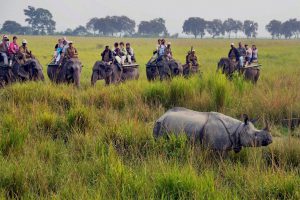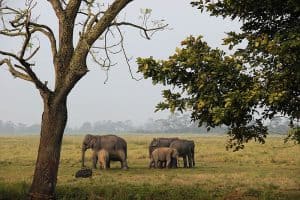
After our exhilarating trip to Shillong, we decided to take our Singaporean guests, Jane and Rachel to the world famous Kaziranga National Park, located in Golaghat and Nagaon districts of Assam. The drive from Shillong to Kaziranga National Park had taken us five hours. As we left behind the blue mountains of Meghalaya, we drove through valleys filled with golden rice fields stretching for miles together on either side of the highway. We stopped at a roadside restaurant, “Seven Sisters”, which served us authentic Assamese non-vegetarian food, served by pretty young girls dressed in traditional mekhela-chadors (Assamese attire).
Kaziranga is a unique bio-diversity park and was declared a UNESCO world heritage site in 1985. Recently the Government of India has declared Kaziranga National Park as one of the 10 Iconic sites in India. Rich in flora and fauna, the park is home to the largest population of the rare and endangered one-horned rhinoceros and the water buffalo. Its rich wildlife also includes elephants, wild boar, porcupine, jungle cat, different species of deer, a wide variety of aquatic life such as turtles, river dolphins and different species of avifauna such as the Great Indian Hornbill, Grey Headed Fish Eagle, the rare Bengal Florican, Adjutant Stork and a variety of water birds, both resident and migratory.
Geographically, Kaziranga National Park is located along the southern bank of the mighty Brahmaputra and a floodplain area with three major types of forest eco-systems: the wetlands, grasslands and woodlands, each serving as niche habitat to a variety of wildlife. The characteristic flora of Kaziranga is the dense and tall elephant grass (locally called ekora) along with the short grasslands on the edges of the water bodies, nourished by the receding floodwaters of the river Brahmaputra. November to March is the best season to visit Kaziranga.

It was dark by the time we had reached Kaziranga. From the guest house, we could hear the distant strains of Bihu songs and drums. The Tourism Department of Assam hosts a cultural night extravaganza for tourists every night. The cultural hall centre was brimming with tourists, enjoying traditional Assamese Bihu song and dance and Jhumur Dance performance by young Adivasi girls from the nearby tea gardens. We stayed at the heritage guesthouse run by the State Forest Department, which served us a delicious home-cooked meal for dinner that comprised of rice, lentils (dal), vegetables and chicken curry.
The next day, we started early at 5am with the elephant safari. The elephant ride was exciting from the start, where we saw many playful baby elephants accompanying their mothers along with the entourage of tourists. The elephants moved slowly in the marshy grasslands which abounded with rhinos, deer and wild boars, all feeding in the early morning hours. The rhinos seemed quite at ease in their natural habitat and kept feeding nonchalantly even when the elephants moved close to them. The most fascinating part of the safari was the baby elephants, who intermittently stopped their mothers to suckle milk. Interestingly, one of the baby elephants had approached to tease a young rhino calf but was quickly chased away by the mother. Apart from the sight of several rhinos grazing peacefully, there were some exhilarating sightings of wild boars, wild cat, water buffaloes and a variety of deer species. Protecting the rhinos from poachers is one of the most challenging tasks of the State Forest Department. Despite incidences of poaching and devastating floods during the monsoon season, the Rhino population has increased and continue to thrive amidst the plenitude of flora and fauna. From an estimated 200 individuals in the beginning of the 20th century, Kaziranga now houses about 2400 Rhinos, which is one of the most successful wildlife conservation efforts in India. Although Kaziranga was declared a Tiger Reserve in 2006, you have to be extremely lucky to have a sighting of the elusive tiger.

The next phase of our safari was done in a Maruti Gypsy. We learnt a lot about the animals and the bio-diversity from the knowledgeable field staff who had accompanied us on the trip. As we drove through tall elephant grass stands on either side of the road, we had witnessed many exotic migratory birds, monkeys and turtles perched on fallen tree trunks in the river. Kaziranga is recognized as an ‘Important Bird Area’ by Birdlife International for the conservation of avifaunal species. Hornbills, Kingfishers, Parakeets, Kites and Vultures are popular birds found in this habitat, apart from the seasonal migratory birds. All over the park there are tall towers known as ‘electronic eye,’ that keeps track of animals and human movement inside the jungle. The devastating 2017 floods in Assam had claimed the lives of a number of wildlife in Kaziranga. The park authorities are now creating earthen highlands to serve as refuge during the flood season.

Visiting Kaziranga National park was an eye-opening experience for our Singaporean friends. As Rachel puts it – “I never realised that India has so much variety to offer, in terms of animals, people and cuisine. What an eye-opening experience for one who has been to almost every part of India except the best part – the north east.”Jane calls her maiden visit to India- “An extraordinary experience. Through this one trip, any misconceptions I originally had about what India had to offer have been dispelled! I can only describe it as an almost out-of-the world experience for me while I was there!”

In June 2017, I had the great opportunity of visiting Kruger National Park in South Africa. I was mighty impressed with the way the authorities care for the animals there and was greatly fascinated by sightings of the Big 5 (animals) and witnessing a pride of lions eating alive a Kudu. I enjoyed the safari at Kaziranga much more due to my natural affinity with the land, being an Assamese. Driving through the tall elephant grass, sightings of colourful birds, and the calming water bodies were both uplifting and enjoyable. The animals in Kaziranga seemed healthier, well-fed and much more at ease in their natural surroundings. No wonder, despite the occasional poaching, the one-horned Rhinos continue to flourish in this land of plenty.
(With inputs from Mrs Ruby Baruah and
Mr Akash Deep Baruah, Director, Kaziranga National Park)











